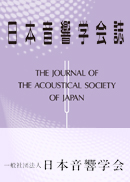巻号一覧

26 巻, 1 号
選択された号の論文の6件中1~6を表示しています
- |<
- <
- 1
- >
- >|
-
小橋 豊原稿種別: 本文
1970 年 26 巻 1 号 p. 1-2
発行日: 1970/01/10
公開日: 2017/06/02
ジャーナル フリーPDF形式でダウンロード (283K) -
池谷 和夫, 久野 和宏, 鹿野 洋治原稿種別: 本文
1970 年 26 巻 1 号 p. 3-15
発行日: 1970/01/10
公開日: 2017/06/02
ジャーナル フリーThe precise analysis of acoustical transmission systems based on the wave theory, in spite of its complexity and difficulty, provides fundamental information for designing acoustic devices and their elements, Many important acoustical transmission systems are of axially symmetric form, and one-dimensional wave equation has been widely used to analyze them. This equation is, however, only applicable in a low-frequency range where the wave fronts are slightly out of planeness. Since appropriate methods have not been devised yet, it has been used beyond the above-mentioned restriction and there come out various discrepancies between theoretical estimations and experimental results particularly on the high frequency side. Therefore it is desirable to establish a method which is widely applicable and highly accurate as well. In this paper, in an attempt to develop a desirable method, an axially symmetric tube with rigid wall is devided into many sections with vary in radius stepwise as shown in Fig. 1, to make an accurate analysis of its acoustic properties with due regard paid to higher order modes in each section. A few examples of the pressure distribution along the axis of the tube calculated by other methods of approximation as well as by the present one are illustrated in Fig. 3. Figs. 4 and 5 show the dependence of the sound field upon the frequency parameter k_<rM> and the ratio of cross sectional areas (r_M/r_1)^2 respectively. The effect of variation of the tube in radius on propagation of sound may be understood by refering to Figs. 6 and 7. Moreover, the relationship between the length of each section and the sound field is further discussed and shown in Fig. 8. The conclusions which can be derived from the results are summarized as follows: 1. When the tube varies in radius gradually, it reflects sound waves to a lesser amount, making the sound field monotonous. 2. On the high frequency side above the cut-off frequency of the (0, 1) mode in which k_<rM>>δ_1 (≒3. 832), the sound field is complicated and greatly different from that on the low frequency side. 3. The sound field calculated from one-dimensional equation may be used in the low frequency range where k_<rM><1. 4. The field calculated when the backward components except the (0, 0) mode are neglected and the tube is terminated with the characteristic impedance ρc of the (0, 0) mode may be effective up to k_<rM><2. 5. The field obtained by neglecting the interference between discontinuities gives fairly good approximation on the whole. 6. Local quantity like a sound field is more sensitive to the method of approximation than global quantities such as transmission and reflection coefficients.抄録全体を表示PDF形式でダウンロード (748K) -
平田 能睦, 伊藤 毅原稿種別: 本文
1970 年 26 巻 1 号 p. 16-24
発行日: 1970/01/10
公開日: 2017/06/02
ジャーナル フリーThe influence of gas flow on the attenuation of sound in a duct with a muffler has been noticed in these thirty years. This problem, however, has been left unsolved to this day. This paper presents an analysis and physical interpretation of the influence of gas flow on the sound attenuation due to a resonator in a duct. Theoretical values of the sound attenuation with flow were compared with measured values over a range of midstream-flow speeds U_0≦50 m/sec, and been shown in close agreement. The theory of resonators had been analyzed by several authors. As well known, the kinetic energy of the motion can be expressed as Eq. 12 in terms of the mass of the aerial piston m and its velocity ξ. If we assume that gas flow carries away the kinetic energy of the additional mass of the aperture, the energy loss of a resonator in time δt can be expressed as Eq. 20, where U^^^- is the mean flow-velocity near the aperture, ρ is the mean density of air and a is the radius of the aperture. From Eqs. 20-26, we get the equevalent resistance density R_u=(4/3π)Mρc, where M^^^- is the Mach number U^^^-/c. And the attenuation characteristic of sound due to a resonator in a duct with gas flow can be expressed as Eq. 33. Eq. 33 shows that the effect of gas flow is in inverse proportion to the area πa^2 of an aperture, that is, the longer the neck of an aperture becomes, the more the effect of gas flow decreases, provided that the conductivity of an aperture G is kept constant. Theoretical curves are shown in Figs. 7-12 comparing with the measured values. As a practical illustration, the measured values of sound attenuation of an automobile engine installed with simple resonator type mufflers are also presented in Figs. 14-16.抄録全体を表示PDF形式でダウンロード (699K) -
加藤 康雄原稿種別: 本文
1970 年 26 巻 1 号 p. 25-33
発行日: 1970/01/10
公開日: 2017/06/02
ジャーナル フリーPDF形式でダウンロード (1000K) -
三浦 種敏原稿種別: 本文
1970 年 26 巻 1 号 p. 34-38
発行日: 1970/01/10
公開日: 2017/06/02
ジャーナル フリーPDF形式でダウンロード (537K) -
仲丸 由正原稿種別: 本文
1970 年 26 巻 1 号 p. 41-42
発行日: 1970/01/10
公開日: 2017/06/02
ジャーナル フリーPDF形式でダウンロード (416K)
- |<
- <
- 1
- >
- >|